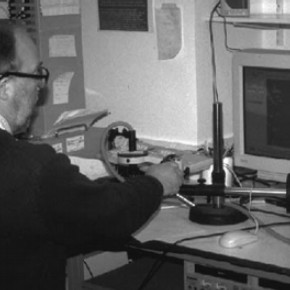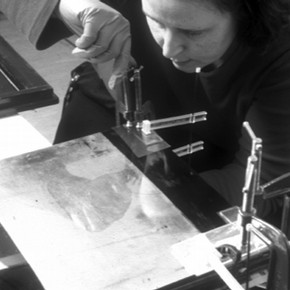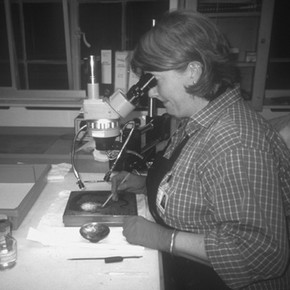Conservation Journal
Summer 2002 Issue 41
Sharing museum skills
The Sharing Museum Skills Millennium Awards was a scheme organised by the Millennium Commission (which is supported by the National Lottery) to provide professional development for individuals and to improve the quality of museums, archives and library special collections for their users. The scheme provided grants to enable staff and volunteers working within these organisations to share, learn and apply new skills through paid secondments. Some 246 grants were awarded. Two conservators and one conservation scientist chose secondments to the Conservation Department at the V&A.
David Howell
Conservation Scientist, Historic Royal Palaces

Figure 1. David Howell examining dust as part of his research into risk assessment for historic textiles on display. Photograph courtesy of Historic Royal Palaces (click image for larger version)
In Autumn 2001 I was given a “Sharing Museum Skills” award to spend six weeks working with Jonathan Ashley-Smith, looking at current understanding of risks to textiles on display, and to identify gaps in our knowledge. The idea was to consolidate Jonathan’s knowledge and experience with risk with my practical and experimental expertise with historic textiles. By strange coincidence my first full day dealing with risk was 11th September 2001.
One aim was to develop a research strategy that could be carried out in a reasonable timeframe at Hampton Court Palace to facilitate structured and coordinated investigations. The first stage was to describe the state of the art regarding what is already known about risks to textiles. Much has been done at Hampton Court to do with humidity and light. Research is currently underway on the effects of dust on textile objects and some work has been done on pollution levels and acidity.
Several gaps in knowledge were identified. The first area of interest was determining a baseline rate at which textiles will degrade no matter what ‘ideal’ conditions they are in. The second area that is little researched is the comparison of risks to objects when putting up and taking down a display and the gains from rotating display objects in terms of light dosage etc. The third area of interest is a risk assessment concerning pollutants, especially low levels of organic acids. It is not really known how the low concentrations of these substances affect textiles in museum or historic house environments. The fourth factor that was felt to be relatively unexplored was risk associated with cleaning objects rather than leaving things dirty.
On this basis several research proposals have been designed and will be implemented over the next few years.
Visits to other institutions
As part of my application I had included visits to other historic houses displaying textiles. The houses chosen were: Brodsworth Hall, Hardwick Hall, and Chatsworth. These three were chosen because of their geographical location (they are all quite close to each other), the different organisations that run them (English Heritage, The National Trust, and Chatsworth Trust), and the different display options chosen.
One of the most interesting aspects of the visit to Hardwick Hall was Jonathan’s perception of the condition of some of the tapestries which he had last seen some twenty years ago. At that time he remembered them as ‘nearly falling off the walls’ because they were in such poor condition. In the intervening period these tapestries have had no conservation treatment, but his opinion was that they now appeared in much better condition! The objects must be in the same or poorer state, but in twenty years Jonathan’s experience and knowledge has changed. Proper condition reports, preferably backed up with scientific assessment of damage, are essential if we are to make real observations on changes to objects.
I regard my secondment as a total success, and I am very grateful to Sharing Museum Skills Millennium Awards for making it possible.
Ticca Ogilvie
Conservator of Antiquities, Bristol Museums &Art Gallery

Figure 2. Author consolidating lifting lacquer surface on shrine panel, Blythe House conservation labs. Photography by Shayne Rivers (click image for larger version)
Sharing Museums Skills brought me to the V&A for six weeks to investigate strategies and decision making in lacquer conservation. I wanted this chance to get to grips with lacquer partly because it is a famously difficult material, and partly because the collection of oriental lacquer and European japanned objects at Bristol City Museum is now in serious need of conservation.
The general practitioner education most object conservators get provides theoretical, but rarely practical, training in this material. The stimulating discussions I had with Shayne Rivers (V&A Senior Furniture Conservator) when she came to advise about our collection made me think that the V&A could provide the sort of experience I was seeking.
I came at a good time. The British Galleries project was finished but still fresh in everyone’s minds, and conservators were very willing to share their insights into the organisational processes behind it –what had worked well and what hadn’t. I had a good opportunity to investigate Concise, the conservation management tool created for the British Galleries project. A strong aura of project management seems to pervade conservation activities at the V&A, and this is particularly impressive to one from a local authority museum where time for effective time-management seems an unaffordable luxury.
It felt very luxurious to be able to spend so much time focused on objects. I began the secondment by conserving four panels from a Japanese shrine required for the Art Deco exhibition in 2003. The enormous quantity of dirt that can sink into a lacquer surface came as a surprise to me. Removing this while retaining soot and heat marks left by candles used in the shrine was a familiar challenge, but using cam-action clamps in consolidating the lifting lacquer surface was a skill I had to learn.
I also worked on several of the exquisite Japanese lacquer objects for the Toshiba Gallery rotation. Many of these had had previous treatment and I learned to recognise the various historic and traditional techniques used.
What I also got from the secondment, of course, was all sorts of less categorisable information through observing how another organisation works, and a renewed sense of proportion in my observation of my own institution.
Towards the end of my time at the V&A we began work on a Chinese red lacquer chair damaged by a water leak in store. The damage made it the ideal candidate for applying some traditional Japanese techniques of lacquer conservation, in particular, cleaning with water and consolidation with urushi. For raw lacquer to polymerise, high ambient humidity is required. I was able to share some of my specialist expertise in creating a controlled humidity workspace within which the conservation could take place. In turn, I was introduced to the tools for and techniques of Japanese lacquer, which Shayne has brought back from her annual training visits to Japan.
The strongest impression I retain of the V&A is the very positive, central place conservation appears to hold there still. Amidst the chasing of too many agendas with too few resources it was enormously refreshing to renew my acquaintance with a world where surface energy interactions between consolidant and substrate appear still able to hold their own against audience advocacy and benchmarking exercises.
Sarah Gerrish
Furniture Conservator, National Museums of Scotland

Figure 3. Cleaning a lacquer writing box (Museum no. W.2-1917). Photography by Sarah Gerrish (click image for larger version)
My personal aim for the secondment was to become more proficient in the conservation of decorative surface finishes. Working as furniture conservator at the National Museums of Scotland (NMS) and previously at the National Museums and Galleries of Wales I mainly conserve vernacular furniture and was looking for an opportunity to enhance my skills to enable me to work on furniture with highly decorative surface finishes. My intention was to use the skills I learnt during my secondment to conserve the European furniture collection held by NMS.
Albert Neher, Head of Furniture Conservation at the V&A, was my mentor during my six weeks in the Furniture Conservation Studio. I was overwhelmed by the willingness of the Section to share their knowledge and skills; everyone was very generous with their time, friendly and kind. The first object I conserved was a 19th century boulle inkstand (Lost 263). Although the decision was made not to replace the missing brass as part of the treatment proposal, I was shown how to make templates and practised cutting brass that would have replaced that which was missing.
I worked with Shayne Rivers for three weeks conserving lacquer objects for rotation of displays in the Toshiba Gallery (figure 1). Shayne made me aware of many articles published on different aspects of lacquer conservation as well as demonstrating cleaning and consolidation procedures. Fi Mallinson and Christine Powell introduced me to general good practice for working on gilded surfaces, I was able to practise these skills working with Fi on a daybed by J.B. Tilliard (W.5 - 1956) destined for an exhibition about Madame de Pompadour at Versailles.
My six week secondment was extremely informative and enjoyable. It is always an experience and of great benefit to meet new colleagues, exchange thoughts, ideas and work practices. I think the scheme is an excellent way for professionals to further their knowledge in a very immediate and direct way. It is far more useful to be able to identify exactly what areas of expertise you would like to expand and to be able to identify who could provide you with that knowledge, than to enrol on a non-specific course which may not particularly be tailored to your requirements.
Acknowledgements
I am grateful to the Conservation Department at the V&A, particularly Furniture Conservation for hosting my secondment. I would like to thank the NMS for allowing me the time to complete my secondment. Finally I am grateful to the Millennium Commission for my generous award.
Summer 2002 Issue 41
- Editorial
- Tiaras - Mount making and installation
- Sharing museum skills
- Training matters: My experience in the painting conservation section
- Developing a collaborative approach to the conservation of lacquer
- Preservation of the Satyajit Ray paper archive: Fieldwork - January 2002
- A Japanese scroll painting conservation course
- A review of adhesives today – Exploring current options and application techniques
- The observed object: the distance between the studio and the gallery
- The importance of being less earnest: Communicating conservation
- Printer friendly version